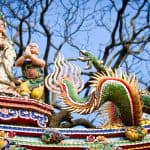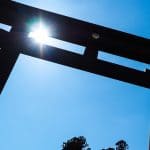Dear reader: This article contains links to products and services that I may be compensated for, at no extra cost to you.
One of the most enticing draws of Southeast Asia is the abundance of mesmerizingly gorgeous temples dotting the landscape.
Shimmering with gold, dominating cityscapes, beckoning the masses to devotion – Southeast Asian temples are testaments the region’s rich colonial history, cultural diversity, religious syncretism, and piousness of its people.
In this article I have compiled the 30 most impressive temples in Southeast Asia. They range from monumental temple cities of the distant past to quirky, modern, artistic endeavors. With one exception (see the third last entry), these temples all belong to the Hindu, Buddhist, or Taoist faiths, or in many cases, combinations of these religions.
I have personally visited more than two thirds of the temples on this list in my travels around Southeast Asia. While I’ve tried to choose a decent mix, not every country in Southeast Asia is represented; I didn’t want to throw in temples just for the sake of including every county.
Read on to find out which ones made the cut!
Table of Contents
Best Temples in Malaysia
Batu Caves, Gombak

Batu Caves are a series of limestone caves that house one of the most visited Hindu temples in the world outside of India. The complex is dedicated to Lord Murugan, the Hindu god of war, and a 42.7-meter golden statue of the god stands at the base of 272 stairs which lead up into the cave temples. The temple is located in the outskirts of Kuala Lumpur.
Batu Caves are also the focal point of Thaipusam, an Hindu festival that brings over a million local Malaysian Indians to the caves. The festival is known for devotees piercing their tongues, cheeks, or other skin on their bodies with long skewers to pay penance to Lord Murugan.
Kek Lok Si, Penang

Kek Lok Si is one of the largest and most impressive Buddhist temples in Southeast Asia. It is a sprawling complex that attracts pilgrims from all over Southeas Asia and combines elements of both Mahayana (primarily Chinese/Northeast Asian) and Theravada (primarily Southeast Asian) Buddhism, the two main branches.
Kek Lok Si is located on a hilltop in the outskirts of Georgetown, Penang. The island state of Penang is known for its rich colonial history, and today its around 40% of its population is Chinese. The temple can’t be missed at Chinese/Lunar New Year, when it is lit up with thousands of lights and lanterns.
Best Temples in Thailand
Dear friends: please don’t confuse Taiwan (which I call home) with Thailand. Here’s my detailed article comparing Taiwan and Thailand!
Wat Phra Kaew, Bangkok

The Temple of the Emerald Buddha, or Wat Phra Kaew, is the spiritual heart and most sacred temple in Thailand. It is found in the Grand Palace, an immense collection of temples and palaces that have been home to the kings of Thailand, who Thais revere, for centuries. Today, it is undoubtedly one of the top things to do in Bangkok.
Wat Phra Kaew houses the Emerald Buddha, which Thais believe protects their nation. Visitors are free to enter without shoes and pray before the sacred statue. The exterior of the wat is beautifully ornate, with long rows of golden garudas at the base of the ordination hall.
Wat Pho, Bangkok

Next door to the Grand Palace, Wat Pho is another of Thailand’s most important temples. It can’t be missed for its 46-meter long, 15-meter tall reclining Buddha, which barely fits into the room built around it. The statue is gilded in gold, and the soles of its enormous feet are inlaid with mother of pearl in the pattern of auspicious Buddhist symbols.
Besides housing the reclining Buddha, Wat Pho is considered the birthplace of Thai massage and still houses a massage school today where visitors can get a traditional treatment. The temple is also considered the first public education center in the country.
Wat Arun, Bangkok
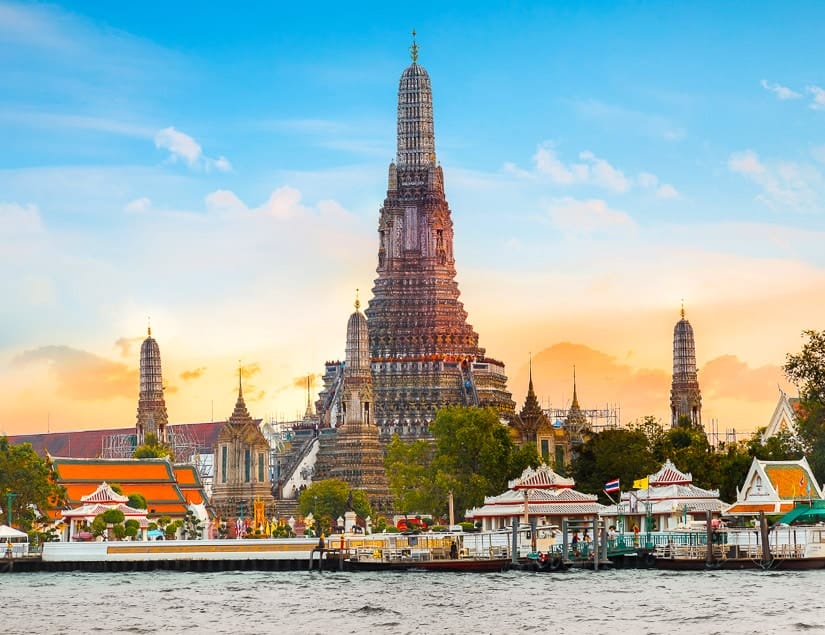
The third and final entry in Thailand’s capital is Wat Arun, which is located on the western bank Chao Phraya, the side less visited by tourists. It is one of the most recognizable landmarks on the Bangkok cityscape.
Viewing Wat Arun’s pearly spires from the opposite bank, or from one of the many boats and river taxis plying the Chao Phraya, especially with the early morning rays of light shining on it, is an unmissable Bangkok experience.
Ayutthaya & Sukhothai
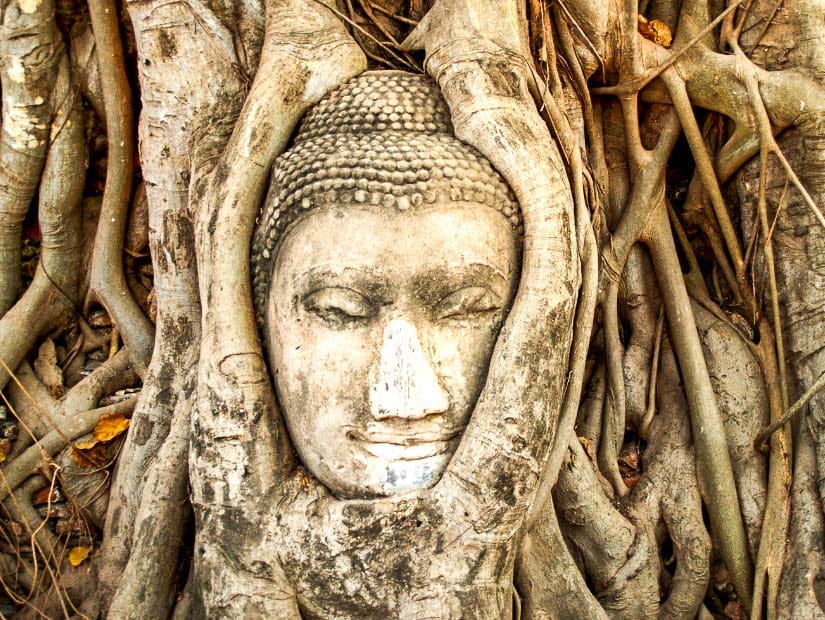
Ayutthaya and Sukhothai are not individual temples, but rather two former capitals of Thailand that feature dozens of ancient temples in varying states of decay. Ayutthaya is 75 kilometers north of central Bangkok, while Sukhothai is closer to Chiang Mai in northern Thailand.
Over 30 Thai kings ruled from Ayutthaya. Today, most of the temple and palace ruins are found on Ayutthaya Island, formed by rivers around it. A stone Buddha’s head encased in the roots of a banyan tree at Wat Mahathat in Ayutthaya is one the most recognizable symbols of Thailand.

Sukhothai was the first capital of Thailand and was in many ways the cradle of Thai civilization. More remote than Ayutthaya, it sees fewer visitors. The best temple ruins in Sukhothai can be seen at Sukhothai Historical Park and Si Satchanalai Historical Park.
Wat Phra That Doi Suthep, Chiang Mai

Chiang Mai, the largest city in northern Thailand and former capital of the Lan Na Kingdom, is home to the next three entries, all essential stops on your northern Thailand itinerary.
Chiang Mai is in many ways a cultural hub of Thailand and is known for its temples. I have a whole article covering the 15 most impressive temples in Chiang Mai, and you can head here to find info for planning your Chiang Mai itinerary.
Wat Phra That Doi Suthep, often shortened simply as Doi Suthep after the mountain on which it sits, is Northern Thailand’s most important temple. It sits at an elevation of over 1000 meters, looking over the city of Chiang Mai.
The temple is accessed via 300 stairs or a cable car. The temple complex is incredibly gorgeous, as are the views looking down on the city. The temple tells the story of Buddhism and attracts pilgrims from around the country.
Wat Sri Suphan (Silver Temple), Chiang Mai
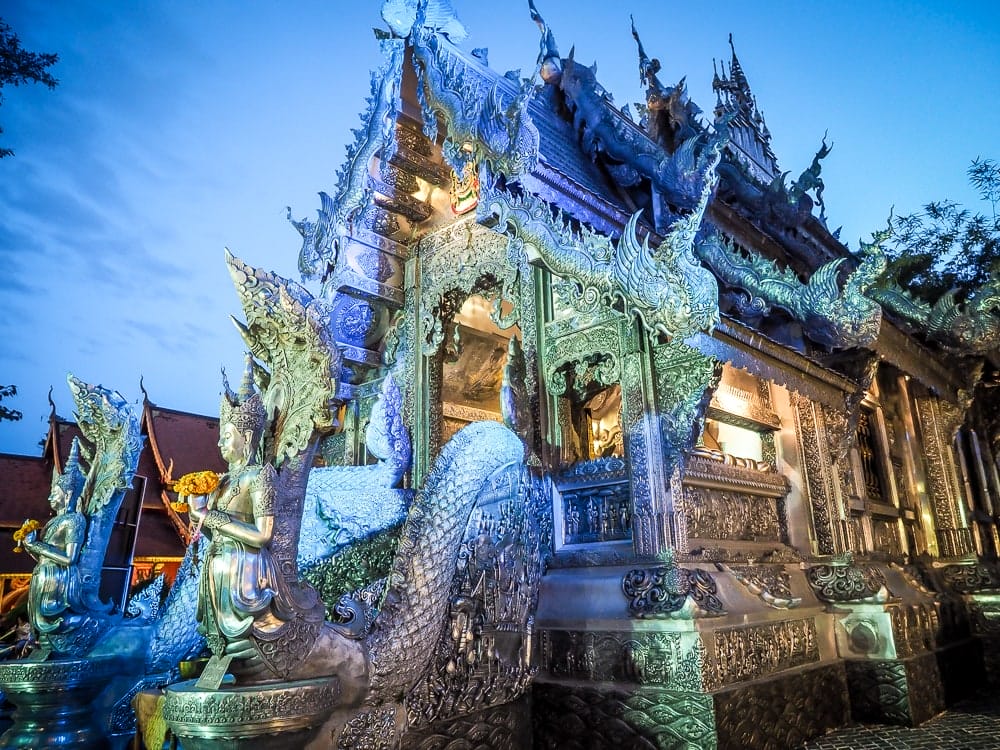
It’s difficult to choose only a few of the many incredible temples in Chiang Mai to include on this list, but I’ve gone with Wat Sri Suplan for the unique fact that it is covered in handcrafted silver decorations.
Both the interior and exterior of the temple are a sight to behold. However, note that the temple still abides by a traditional rule that women are not allowed to enter it.
Silversmiths can also be observed on the temples grounds, and like many other temples in town, you can sit and have a chat with resident monks at designated times.
Wat U Mong, Chiang Mai

In contrast to most of the temples mentioned above, Wat U Mong is buried in the forest in the outskirts of Chiang Mai. The temple has a tranquil natural setting where many animals can be seen and fed.
Wat U Mong’s most notable feature is its network of underground tunnels below the main chedi. Visitors can explore the tunnels and pray in the small shrines found in its various nooks. The temples dates back to the 14th century but was abandoned and then restored in the 1940s and reestablished as a temple in the 1960s.
Wat Rong Khun (White Temple), Chiang Rai

We now move further north to Chiai Rai near the Golden Triangle, where the countries of Myanmar, Thailand, and Laos meet. Wat Rong Khum is another of the most unique temples in Southeast Asia.
More precisely, Wat Rong Khun, commonly called the White Temple of Chiang Rai, is not a temple but an artistic display built on top of an original temple. Local artist Chalermchai Kositpipat bought and redecorated the temple in white. It is an ongoing project, with plans to build a religious complex surrounding the temple.
The White Temple is filled with bizarre and extravagant imagery. It is even said to have the most beautiful and ornate restroom building in all of Thailand.
Wat Rong Seur Ten (Blue Temple), Chiang Rai
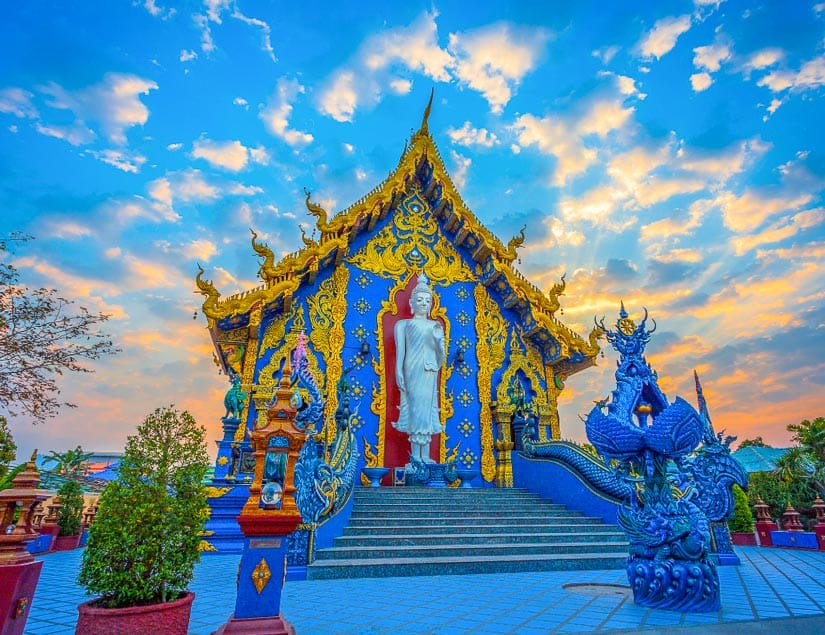
Chiang Rai now has a second temple known for its unusual color: Wat Rong Seur Ten, or the Blue Temple. The temple’s main hall was only completed in 2016, and construction on other parts of it is ongoing.
It is said that locals built the temple on top of a long abandoned former temple, and its Thai name refers to the tigers that were thought to once jump over the river nearby. Like the White Temple, it is located just outside of Chiang Rai’s city center.
Sanctuary of Truth, Pattaya

Venturing now to southern Thailand, Sanctuary of Truth is yet another totally atypical modern Southeast Asian temple that earns its spot on this list. The temple is notably built entirely of teak and other woods, including all the sculptures decorating it.
The temple is a project of a Thai businessman and is built in the style of Ayutthaya temples. It is located on the coast of Pattaya, which is known for excessive tourism and some of its shadier aspects, as well as having one of the closest beaches to Bangkok.
Chalong Temple & Big Buddha, Phuket

Chalong Temple is the most famous places to visit in Phuket, Thailand’s largest island, and one of the most beautiful temples in Southern Thailand.
Near the temple, sitting atop Nakkerd Hills, the spectacular 45-meter tall, ivory white Big Buddha can easily be visited on the same trip and is accessed via a winding road up the mountain. The Bug Buddha can be seen from all over the island of Phuket and is its most famous landmark.
Read about my family’s first to Chalong Temple and the Big Buddha in this article.
Best Temples in Myanmar (Burma)
Bagan

Comparable only to Angkor Wat in Cambodia in terms of sheer size, Bagan was the capital of a vast kingdom from the 9th to 13th centuries. Today, it features there are remains of nearly 4000 pagodas in Bagan spread over an area of 104 km2. Some of these are well maintained active places of worship, while others are nothing but foundation stones.
Some of the great pleasures of visiting Bagan include seeing the sunrise or sunset above a landscape of temple spires poking out from the jungle, cycling between the ruins, or observing the scene from above in a hot air balloon. Read more about Bagan and other incredible temples across the country in my article covering the most beautiful temples in Myanmar.
Shwedagon Pagoda, Yangon

Shwedagon Pagoda is the most important and sacred Buddhist temple in all of Myanmar. The gold-covered pagoda is the tallest structure in Yangon; the local government has set a limit of 75% of the temple’s height to make sure no other structure gets close to it in height.
The pagoda is comparable to Wat Phra Kaew in Bangkok for its historical importance to the local people, and even features a “Jade Buddha” of its own.
Kyaiktiyo Pagoda

Kyaiktiyo Pagoda in Myanmar’s Mon State is a small pagoda built atop a massive, gold-covered boulder that is perched precariously on the edge of a cliff. Legend has it that the boulder is standing on top of a strand of the Buddha’s hair.
The pagoda is located atop Mt. Kyaiktiyo and reached via a pilgrimage route. Male visitors are permitted to approach the rock and apply gold leaf to it, but unfortunately, women are not.
Hsinbyume Pagoda, Mandalay

Much like Chiang Mai is the cultural hub and temple city of Northern Thailand, Mandalay possess the same role in Myanmar. Hsinbyume Pagoda is an atypical Burmese temple in color and design, making it totally unique.
Hsinbyume Pagoda is entirely white and features seven levels with undulating stone rails between them. Photographers will love it, especially if you have a chance to catch some red-robbed monks peeking out from one of the levels. The temple is said to represent the Buddhist mythical Mount Meru.
Kuthodaw Pagoda, Mandalay

Another temple in Mandalay that can’t be missed is Kuthodaw. The temple contains what is considered to be the world’s largest book, which is inscribed on 729 giant marble slabs, each of which is housed in its own white stupa.
The white stupas surround he main pagoda, which is gold-covered and stands 57 meters tall.
See my articles on the 30 best temples in Taipei, Taiwan and the 10 best temples in Busan, South Korea.
Best Temples in Cambodia
Angkor Wat

Angkor Wat means “Capital of Temples,” and it is literally that, an entire city of ancient temples. Angkor Wat is the world’s largest religious monument by total land area, spreading over 402 acres of land. The complex of Hindu temples was once the center of the great Khmer Empire, which occupied most of mainland Southeast Asia.
Some of the most impressive temples in Angkor Wat include the main temple of Angkor Wat, the serene stone faces of the Bayon, and the temple walls being reclaimed by the jungle at Ta Prohm. The temple grounds are an active place of Buddhist worship today, and collectively they are surely one of the most impressive temples in Southeast Asia and the world.
See here for a detailed itinerary for visiting Angkor Wat.
Koh Ker, Preah Vihear

Journey off the beaten track 120 kilometers north of Angkor Wat to discover this similar, but far less visited Khmer temple complex.
Koh Ker was an important city during the Khmer empire. The major appeal today is the lack of tourists compared to Angkor Wat, but assuming you see Angkor first (which usually takes about 3 full days of temple hopping), only true temple aficionados will likely want to see even more at Koh Ker.
Those that do make the trek say that it has a different feel than Angkor Wat, with some temples even described as Aztec-like.
Wat Phnom, Phnom Penh

Wat Phnom is the heart of Cambodia’s capital, Phnom Penh, and lends the city its name. It is the central and highest point of the city, standing on a 27-meter hill in an otherwise flat city. The temple dates to 1372 but has been rebuilt many times.
The most impressive feature of the temple is its grand staircase guarded by lions and nagas. Wat Phnom is a religious focal point of the country’s people, of much more than 95% are Buddhist.
Phnom Chhngok, Kampot

For something really unique in Kampot province, southern Cambodia, check out Phnom Chhnork, a Hindu cave temple. To get there, you’ll need to cross rice paddies then ascend 203 steps to enter the cave system.
Inside you’ll be greeted with huge stalactites, one of which represent the sacred lingam (phallic symbol), before reaching the brick temple dating to the 7th century.
Best Temples in Indonesia
The following five Indonesian temples belong to the Hindu & Buddhist religions and are concentrated on the islands of Java and Bali, although there are countless other beautiful Indonesian islands to consider visiting.
Borobodur, Java

Borobodur is without a doubt one of the most impressive ancient temple ruins in Southeast East. The ancient Buddhist temple is located in Central Java, the world’s most populous island. Like Angkor Wat, it is a testament to the spread of Indian religions in Southeast Asia and dates to the 9th century.
Two things stand out the most about Borobodur. First are the beautiful carved reliefs on the system of staircases that lead pilgrims to the top of the step pyramid. The second are the many seated stone Buddhas, some of which are in perforated stupas, and others which are headless.
Borobodur is not so impressive when viewed from afar, but up close, it’s all about the incredible details. Every element of the structure is imbued with religious meaning, and from above, the entire structure is in the shape of a mandala.
Prambanan, Java

Prambanan was the Javanese Hindu kingdom’s answer to Buddhist Borobodur, built around the same time, and only 50 kilometers away from it. It is the largest Hindu ruins in Southeast Asia after Angkor Wat.
The massive stone temples of Prambanam are known for their tall, thin, pointed towers, in contrast to Borobodur’s outward build. While Borobodur is the more impressive of the two, both can easily be visited in a single day.
Pura Tanah Lot, Bali

The coastal temple of Pura Tanah Lot is one of the most popular tourist attractions in Bali. The temple sits on a rocky outcrop (becoming an island at high tide) on the southwest coast of Bali, a short drive from the capital, Denpasar.
Pura Tanah Lot is one of seven important coastal temples in Bali and is dedicated to the god of the sea. The locals believe that poisonous sea snakes protect the base of the island.
See see how to fit the temple into your plans, consult this recommended two-week itinerary for Bali.
Pura Besakih, Bali

Built on the slopes of Mount Agung, the highest active volcano in Bali, Pura Besakih is the Hindu island’s most sacred temple and one of the top places to visit in Bali. The temple is built on six levels around 1000 meters up the volcano.
The site of the temple has been a place of worship since historic times. A favorite feature of many visitors and especially photographers is the candi bentar, or split gateway, at the temple’s entrance. When Mount Agung erupted in 1963, the lava flow missed the temple by mere meters, which the locals regarded as a miracle.
Pura Ulun Danu Bratan, Bali

The last of three Balinese Hindu temples to make this list, Pura Ulun Danu sits on the shore of Lake Bratan in the mountains of central Bali. The nearly 400-year-old temple was built in honor of Shiva, and many ceremonies dedicated to Dewi Danu, the Balinese water goddess, take place there.
The temple is popular among photographers for the way it reflects so beautifully on the lake. For the high chance of seeing the temple reflecting on the lake, visit in the dry season, between April and September, which is generally considered the best time for visiting Bali.
For a far more off-the-beaten-track experience, another temple worth checking out nearby is the Gunung Kawi Sebatu Water Temple, one of the hidden gems of Bali.
Best Temples in Laos
Pha That Luang, Vientiane
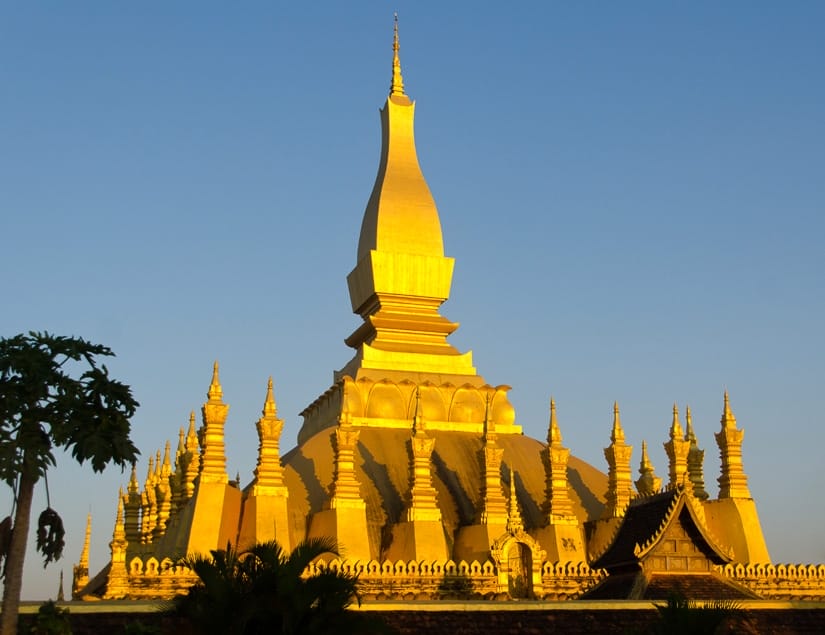
The gold-covered Buddhist stupa Pha That Luang is the important in the landlocked Buddhist country of Laos. It is found in the capital, Vientiane, and many consider it a national symbol.
The pinnacle of Pha That Luang’s stupa rises 44 meters in the air and is covered in real gold, while the rest of the temple is painted a gold color.
Besides Pha That Luang, visitors to Laos also can’t miss Xieng Khuan, the statue-filled “Buddha Park,” as well as the city of Luang Prabang in northern Laos, which is known for its many historical Buddhist temples.
The Temples of Luang Prabang

Luang Prabang, the capital of northern Laos, is famous for its numerous temples and the whole city is a UNESCO World Heritage Site. These include ancient stone temples such as That Makmo and Wat Visounnarath, as well as newer glimmering golden ones like Haw Pha Bang at the Royal Palace.
For something really special, hike up to the cave temple and That Chomsi on Mount Phousi, overlooking the city and Mekong River. It is without a doubt one of the most beautiful places in Laos!
Wat Phou Salao, Pakse

In the far south of Laos, the city of Pakse is home to another of Laos’s most enticing temples: Wat Phou Salao. The temple’s centerpiece is the huge golden Buddha on a prime spot commanding an incredible view of Pakse and the Mekong River.
The best way to approaching is by going on a 4-kilometer hike up the hill, and try to be there for sunset.
Wat Phou, Champasaak

Just about everyone has heard of (or been to) Angkor Wat in Cambodia. But far fewer are aware of the ruins of Wat Phou in southern Laos, which were once part of the Khmer empire.
The ruins cover an enormous area, with many of them leading to a shrine with a lingam dedicated to Lord Shiva. Like Angkor Wat, it started as a Hindu-Buddhist complex, but has now for centuries been a center of Therevada Buddhism.
Best Temples in Singapore
Sri Mariamman

Representing the Indian community which makes up 7.4% of Singapore’s population, Sri Mariamman is the city state’s oldest and most impressive Hindu temple and is found, ironically, in Chinatown district, on land that was once set aside for the places of worship for arriving immigrants from different parts of Asia.
Sri Mariamman replaces an earlier temple built on site by migrants from Tamil Nadu. It is built in the Dravidian style of Southern India, and features an incredibly ornate and colorful six-tiered gopuram (monumental entrance tower) filled with carvings of Indian deities. Each subsequent layer going up is smaller, giving the illusion of greater height.
Buddha Tooth Relic Temple

A few blocks away from Sri Mariamman, the relatively modern (2007) Buddha Tooth Relic Temple is today the city’s most impressive Buddhist temple. The large temple complex is built in the Chinese Tang style and houses a sacred tooth relic of the Buddha.
The Buddha’s tooth is housed in a large stupa containing 320 kilograms of gold. The temple looks especially striking when it is lit up at night.
Best Temples in Vietnam
For much more than what we cover below, see this comprehensive guide to the best temples in Vietnam.
Tây Ninh Holy See (Cao Đài Temple)
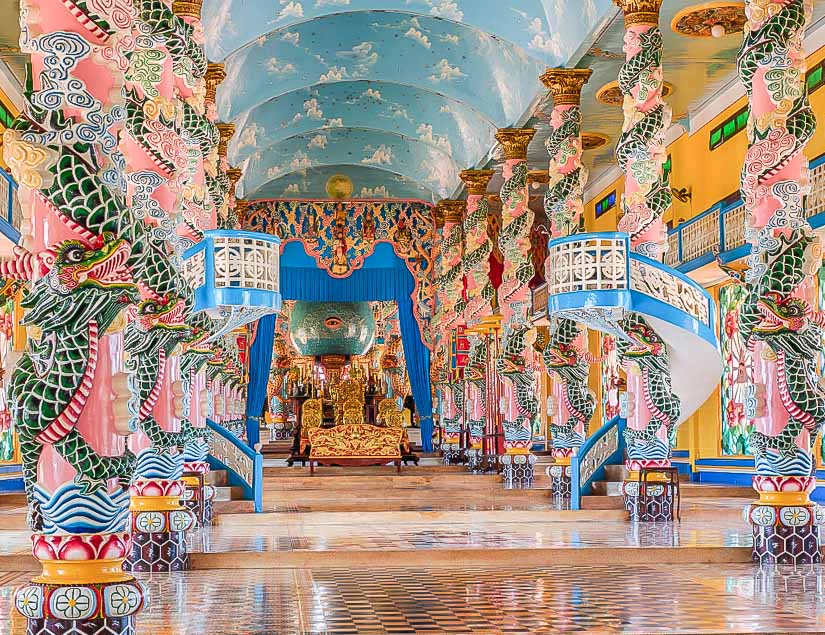
The only temple on this list to fall outside of the Hindu/Buddhist realm is Tây Ninh Holy See, the main temple of the Cao Dai religion. Caodaism is a syncretic religion, combining aspects of various religions, and has an estimated 4.4 million followers in Vietnam and abroad. The temple is located outside Saigon in southern Vietnam and as an essential stop on most visitors’ Vietnam itinerary.
The Cao Dai temple is truly a sight to behold. From the outside, it looks akin to a colorful church or mosque with Chinese touches. But on the inside, the temple is especially wild. Dragon-wrapped columns, a sky painted on the vaulted ceiling, and a globe with a giant eyeball on it at the shrine combine to form a kaleidoscope of colors, imagery, and beliefs.
Tran Quoc Pagoda, Hanoi

Of the many impressive temples across Vietnam, I’ve chosen Buddhist Tran Quoc Pagoda in Hanoi for its beautiful location on an island on the shore of West Lake. The pagoda is the oldest in the city, at nearly 1500 years.
The temple can be reached via a causeway connecting it the shore. Try to visit in the early evening, when the temple’s pagoda reflects beautifully on the surface of the lake. The temple also features a tree grown from a cutting from the original Bodhi Tree in Bodh Gaya, India.
Best Temple in Brunei
Teng Yun Chinese Temple, Bandar Seri Begawan

Teng Yun Temple, or the “Temple of Flying Clouds” is the oldest and only Chinese temple in Brunei, the Islamic sultanate on the northern coast of Borneo. The temple was originally built in 1918, a prosperous time for Chinese merchants in the country.
After surviving the bombings of WWII, the land of temple was acquired by the government. The temple was demolished and rebuilt in its present form in 1960. It stands out for its sleek design and vibrant red color, and is found opposite the city’s largest open-air market, backed by a modern building.
Well, you’ve made it to the end of my list of the most beautiful temples in Southeast Asia. There are of course many amazing temples that have been left out, so I am keen to hear your thoughts. Did I miss your favorite temple in Southeast Asia? Let me know in the comments!

